Lunar horoscope - Year of the snake

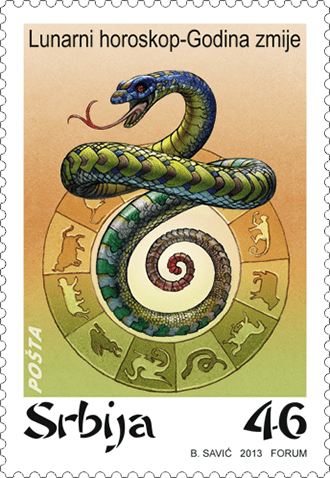
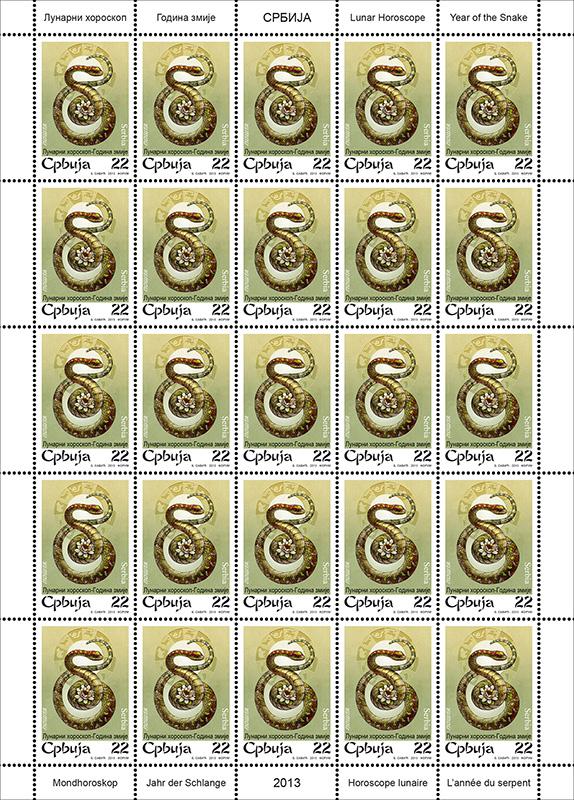

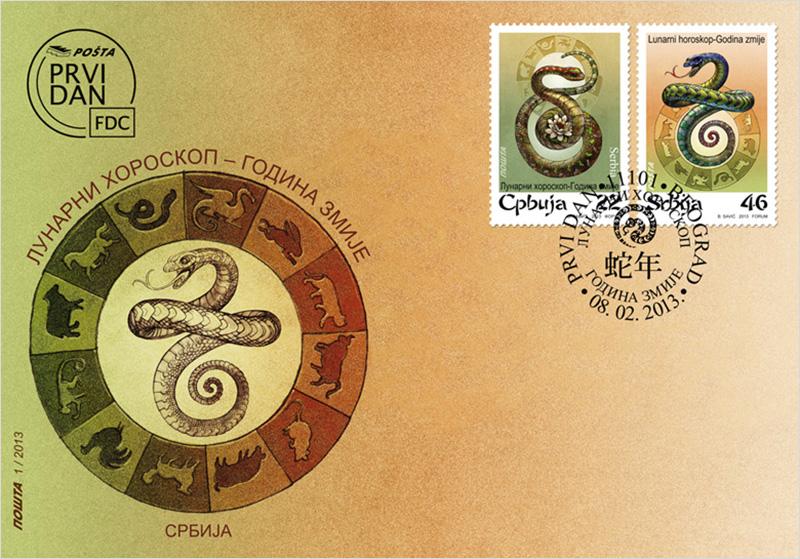

Chinese astrology is based on the traditional astronomy and calendars. It also has a close relation with Chinese philosophy (theory of the three harmony, heaven, earth and water) and principles: the wu xing teachings, yin and yang, five planets, the 10 Celestial stems, the 12 Earthly branches, the lunisolar calendar, etc.
The lunar calendar is based on cycles of the moon phase. Most lunar calendars are in fact lunisolar calendars. That is, months are kept on a lunar cycle, but then intercalary months are added to bring the lunar cycles into synchronisation with the solar year. Chinese, Hebrew, and Hindu calendars are lunisolar, as well as most calendar systems used in antiquity. Lunar calendars differ as to which day is the first day of the month. For some lunar calendars, such as the Chinese calendar, the first day of a month is the day when an astronomical new moon appears in a particular time zone.
The Chinese horoscope falls into the oldest known horoscopes. It consists of 12 signs of which each one rules over a lunar year. These Zodiac signs have the names of animals (Rat, Ox, Tiger, Rabbit, Dragon, Snake, Horse, Sheep, Monkey, Rooster, Dog and Wild Boar). In the Chinese horoscope, besides basic signs, very important are also elements: Wood, Metal, Water, Fire and Earth. Every person born in the year of the assigned animal is said to have personalities and traits resembling that animal.
According to the Chinese zodiac, 2013 the year in the sign of snake covers the period from 10th February 2013 to 30th January 2014. This sign is related to the mystery, self-confidence, persistence, assertiveness, wisdom. People born under the sign of snake radiate strength and confidence, they are wise and calculated, their moves make precisely and deliberatly. They are very emotional and passionate, honest and loyal. Rarely are mediocre- they are either at the top or at the bottom. At the same time, almost always, they are successful in business and in family life.
2013th will be marked by progress, but with focus on discipline and attention to details.
Artistic realization of the stamps: Boban Savić, М.А, academic painter.
Museum exhibits 50 Years of the Historical Museum of Serbia






Historical museum of Serbia is a complex type museum whose task is to preserve the national history heritage and keep the public informed about it. It was founded in 1963.
The Historical museum of Serbia is in charge for artistic and historical works of importance for Serbian history and weapons and military equipment from the end of middle Ages, uniforms, flags, emblems, realias and memorial items connected to important persons and events, maps, plans and atlases, commercial and technical mass produced materials, stamps, posters, photographs and postcards with historical content. The museum also provides protection of immovable estate and other items of special significance for history and culture of the Serbian people that are located abroad, such as Hilandar, but also in Hungary, Romania and Trieste, and in the newer times in Croatia and Bosnia and Herzegovina.
During his half-century long history, the Museum has organized representative exhibitions that were displayed not only in Belgrade and other cities in the country but also in Europe and the U.S. It hosted a number of exhibitions from other institutions in the country and abroad.
The Museum has its publication - the Journal of the Historical Museum of Serbia, whose numbers were first published by the Museum of the First Serbian Uprising. Also, the Museum issued several very important special issues. For outstanding contribution to the development of culture in Republic of Serbia and pan-Serbian cultural space, the Museum has received Vuk Award in 1997.
The motif on the stamp with the face value of 22.00 RSD: the Gospel of King Aleksandar Obrenović, 19 century, gift from the brotherhood of the monastery Zograf, 1896, made in Kiev Pechersk Lavra; black enamel, gold, enamel, precious stones. The motif on the vignette: the Watch from the legacy of Obrenović dynasty, 19 century, Breguet, Paris, gold, enamel. The motif on the stamp with the face value of 55.00 RSD: the Crown of King Petar I Karadjordjević, made in 1904 in the jewellery workshop of Falize brothers (Falize Frères), Paris, made according to the draft of Mihailo Valtrović, cast from handle of Karadjordje's cannon; gilding, enamelling, bronze, synthetic gemstones. The motif on the vignette: Insignia of King Petar I Karadjordjević (scepter, globe and buckle for the cape), made in 1904 in the jewellery workshop of Falize brothers, Paris; bronze, enamel. The motif on the envelope: the Watch from the legacy of Obrenović dynasty, 19th century, Breguet, Paris, gold, enamel. In the background - Bracelet from the legacy of Obrenović dynasty, 19th century, J. W. Swoboda, Vienna, gold, rubies, diamonds, tourmaline, enamel.
Graphic realization of the stamps: Nadežda Skočajić, graduated graphic artist.
Expert collaboration: Historical museum of Serbia; photos used herein were taken by Rastko Šurdić.
Easter
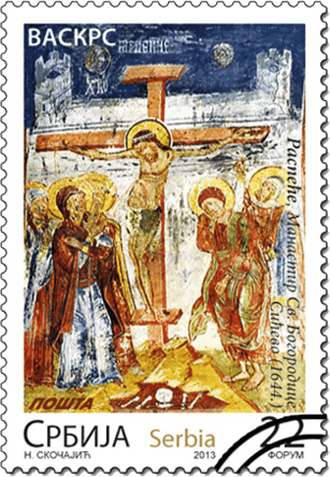





Easter Sunday is the date of the annual celebration of Christ’s resurrection. The Orthodox Church celebrates the Easter on the basis of the Julian calendar. The date is not fixed, but denotes the same season of the year and the same relationship to the preceding astrono-mical full moon that occurred at the time of His resurrection in 30 A.D.
Easter is one of the most important Christian holidays. This is a day of eternal joy, the day when Christ, the Son of God, conquered the death. By the act of resurrection Jesus Christ proved his divine power and opened the gate of eternal life, joy and happiness that we can find in our faith. On Easter Sunday morning the church bells toll, and the people, together with their priest, go round the church. After the third round they stand in front of the church doors. The priest carries the cross, candle and the censer and chants the Easter hymn. The doors open and they enter the church where liturgy continues. When it ends, people greet each other with the words: “The Christ has resurrected”, and “Indeed he has”. There are many customs connected with Easter Sunday, and certainly one of them that children like best, is colouring and offering of eggs. The first egg is coloured red and in many parts of our country it is called “The house keeper” and is kept for the whole year, until the next Easter.
The frescoes from monastery church Most Holy Theotokos in Sićevo Gorge, near Niš, are presented on the stamps and envelopes. This church was built and painted in 1644 at the time of patriarch Paisios and priest Jovan, and with the efforts of the benefactor Veselin. The church narthex was repainted at the end of 19th century with the scenes from the Akathist to the Theotokos, the sublime creation of Byzantine church poetry.
Motif on the stamp of nominal value 22.00 RSD: Crucifixion (fresco, 1644); Motif on the stamp of nominal value 46.00 RSD: Harrowing into Hell (fresco, 1644); Motif on the envelope: Entry of Christ into Jerusalem (fresco, 1644).
Graphic realization of the stamps: Nadežda Skočajić, graduated graphic artist.
Expert collaboration: the Serbian Orthodox Church, the Orthodox Eparchy of Niš; Miša Rakocija, PhD, art historian, the Institute for Protection of Cultural Monuments of Niš.
Art



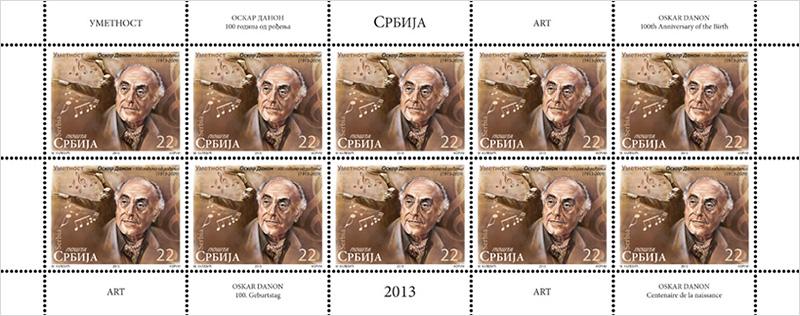





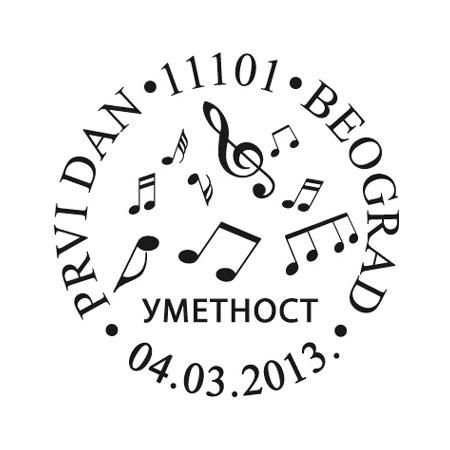
Oskar Danon – 100th Anniversary of the Birth
Oskar Danon was born on 7th February 1913 in Sarajevo, and died in Belgrade on 18th December 2009. He grew up enshrined in music (his mother Hani Danon played piano). He was a Serbian and Yugoslav conductor and composer, a member of Academy of Science and Arts of Bosnia & Herzegovina. He completed conducting and composition studies at the State Conservatorium in Prague, and was also awarded doctor’s degree in Philosophy at the Charles University in Prague. He was the first director of Opera and Ballet of the Belgrade National Theatre after the World War II, and then their Artistic Director and a permanent visiting conductor. Mr Danon was a chief conductor of the Slovenian Philharmonic Orchestra in Ljubljana and Symphony Orchestra of Radio Zagreb; as well as a full-time professor at the Belgrade Music Academy. In 1938 in Prague, after the graduation concert with the Conservatorium orchestra, he obtained his Ph.D. degree by defending the thesis Claude Debussy and Music Impressionism: the Start of Decadence in Music. In the same year, he founded an artistic company, called Collegium Artisticum.
After Yugoslavia collapsed on 6th April 1941, all the leftists gathered around Collegium had to go undercover, as the secret police had lists with their names. On 16th July 1941 Oskar joined the Yugoslav Partisans (his nick-name was Tsigo (“The Gypsy”)). During the war, he composed several songs, such as: Romanijo visokoga visa, Ide Tito preko Romanije, Pesma bosanskih proletera. By text of poet Vladimir Nazor, he composed Comarade Tito, All That Was Under the Ashes... At the Second session of AVNOJ in Jajce, he was granted the rank of major. For a time in 1944, with the Theatre of National Liberation he lived in Bari, Italy, where he held performances in the Teatro Piccinni in the spirit of real professional theatre. It was then that he was assigned to form a chorus, orchestra and ensemble in the Belgrade National Theatre, which would later hold a ceremonious performance on the occasion of the Great October Revolution.
After the war, Danon came to Belgrade to live. He was the director of the Belgrade Opera House (1945-1963), a professor in opera studio at the Belgrade Music Academy (1963-1970), a chief conductor of Slovenian Philharmonic Orchestra in Ljubljana (1970-1975), a chief conductor of the Symphonic Orchestra of Radio Zagreb (1980-1982). Also, he was the president of the Association of Music Artists of Serbia, the first Secretary General of the Composers Union of Yugoslavia, and he renewed the Belgrade Philharmonic Orchestra. With the ensemble of Belgrade Opera House, he had very successful performances in the renowned opera houses and concert halls all over Europe, North America, Soviet Union and Japan.
Richard Wagner – 200th Anniversary of the Birth
Wilhelm Richard Wagner (Leipzig, 22nd May 1813 – Venice, 13th February 1883) was a German composer, poet, essayist and music theorist. He was a crucial personality in the history of music. As one of the greatest creators of operas (or “musical drama”, as he used to call his own), he laid the foundations of 20th century classical music, especially in his “Tristan and Isolde”, where he abundantly used chromatism and where we can find the root of atonality. He is noted for its use of leitmotifs. In his essays, he laid the theoretical basis of “the whole art” (Gesamtkunstwerk in German), according to which the musical drama is the most perfect form of artistic expression, since it encompresses all other branches of arts and has the potential to “redeem the world”, which was the reason why he was still alive proclaimed megalomaniac by many those days critics.For all his operas, he wrote the libretto himself (or, the “poem” by Wagner’s terminology), which is a consequence of the belief in “total art”, and he invested a big effort to create them as he imagined. With this aim, he founded his own opera house. In addition, Wagner was also a great conductor who, according to the famous Wilhelm Furtwangler, together with Hans von Bulow, led to the creation of a new generation of conductors. Wagner is considered by many the greatest composer of opera (Der Fliegende Hollander, Tannhauser, Lohengrin; master pieces: Tristan und Isolde, Der Ring des Nibelungen, Die Meistersinger von Numberg, Das Rheingold, Die Walkure, Siegfried, Gotterdammerung, Parsifal). He also wrote a symphony in C major and E major, concert overtures (Polonia, Rule Britannia, Faust - overture in D minor, piano sonata in B flat major, A flat major and As major, American Centennial March, Imperial March.
Giuseppe Verdi – 200th Anniversary of the Birth
Giuseppe Verdi (Le Roncole, 1813 - Milan 1901) is the greatest composer of the mature Italian bel canto. He was born in the village of Le Roncole, near Parma in Italy. Already when he was eleven years old he became organist at the local church. The first person who noticed his talent was a local merchant and music lover, Antonio Barezzi, who helped him, along with the town of Busseto, to enrole at Milan music school, in 1832. However, the director of the Conservatory hesitated to accept Verdi, allegedly because he was older than the statute permitted, but more likely because he lacked confidence in his talent. Therefore, over the next three years, Verdi was working with the opera conductor Lavigne, a pragmatic man, whose catechism was Mozart’s Don Giovanni. In 1833, the organist Provesi dies in Busseto and Verdi succeeds him . In 1839. Verdi made his debut as an opera composer, which brought him the success and the possibility to move to Milan. This opera was Oberto, Count of San Bonifacio. After this he wrote many other operas which made his name successful, first in Italy, and then in the world. Verdi also wrote two sacral works - Requiem, 1874, in memory of Alexander Manzoni and the work Four Sacred Pieces, 1898, which consists of Ave Maria, Stabat Mater, Te Deum and Laudi alla Vergine from Dante’s Paradise. Verdi died in Milan where he lived and worked for many years. Other Verdi’s operas are: Un giorno di regno, Nabucco, I Lombardi alla prima crociata, Ernani, I due Foscari, Giovanna d’Arco, Alzira, Attila, Macbeth, I masnadieri, Il corsaro, La battaglia di Legnano, Luisa Miller, Stiffelio, Rigoletto, Il trovatore, La traviata, Les vepres siciliennes, Simon Boccanegra, Un ballo in maschera, La forza del destino, Don Carlos, Aida, Otello, Falstaff.
Artistic realization of the stamps: MA Marina Kalezić, academic painter.
1700 years of edict of Milan

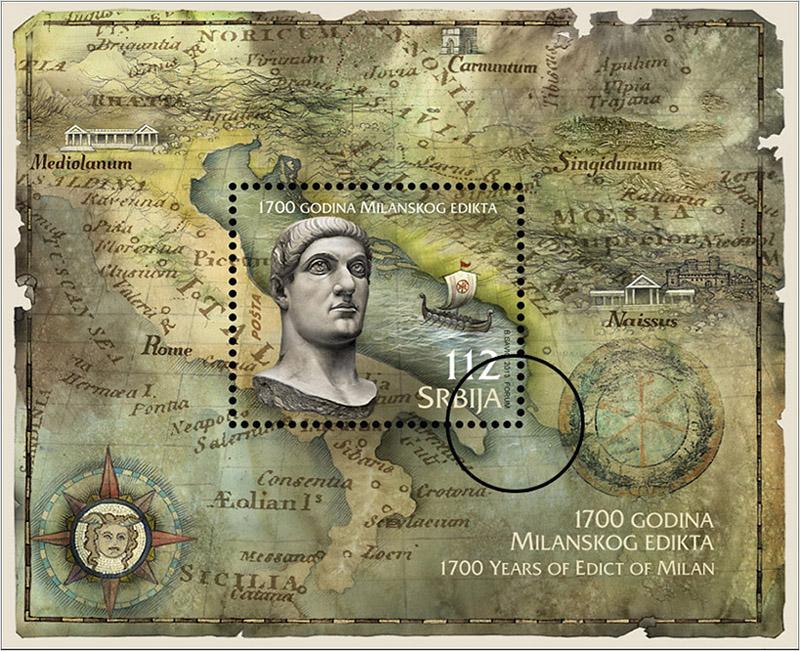





The best-known piece of legislation in the history of mankind is a tolerance of religion edict, known as the Edict of Milan, which was signed in the spring of 313. by the Roman emperors, Constantine the Great (272-337) and Licinius. This edict made the Christian religion equal with other religions in the area of the Empire and conditions were acquired so few decades later (395) Christianity became state religion. For their accomplishments, the Emperor Constantine and his mother, Empress Jelena, were canonized as saints and celebrated on 3rd June. The final result of the Edict of Milan is that nowadays one-third of humanity professes faith in Christianity.
The Programme of the Government of the Republic of Serbia for the denoting of 1700th anniversary of the Edict of Milan throughout 2013. envisages a series of cultural-artistic events that are dedicated to this aniversary in Niš, Viminacium and Belgrade.
Niš, the hometown of Constantine the Great, in 1913. has also marked the anniversary of the Edict of Milan. Throughout the 2013, the city of Niš represents the spiritual capital of Serbia, in which is held a series of cultural-artistic events that are dedicated to the Edict of Milan jubilee.
In the glory of the Edict of Milan, the Serbian Orthodox Church organizes ecumenical gatherings, religious lectures, as well as a joint liturgy of the Orthodox churches.
Through all mentioned events, the Republic of Serbia promotes the idea of tolerance, that once initiated Constantine the Great.
Expert collaboration: National Museum Niš.
Artistic realization of the stamp: MA Boban Savić, academic painter.
150 years of the founding of the International committee of the Red cross




An ambitious idea of Henry Dunant (1828-1910) to alleviate human suffering and provide assistance to the victims of armed conflicts, natural and other disasters became reality 150 years ago with the foundation of the International Committee of the Red Cross and Relief Societies, known today as National Red Cross and Red Crescent Societies.
Although in the beginning its sole objective was to ensure protection and assistance to the wounded in the battlefields, the scope of the International Committee of the Red Cross activities, as well as of the entire International Red Cross and Red Crescent Movement, has been constantly expanding to address ongoing humanitarian challenges. Through its direct action around the world, as well as by promoting of the development and respect of international humanitarian law, the International Red Cross and Red Crescent Movement, as the largest humanitarian network of the world, still strives to improve the lives of victims and respond to all kinds of humanitarian crises on an impartial, independent and neutral basis.
The Red Cross of Serbia, at that time named the Serbian Red Cross Society, was founded and international recognized by the International Committee of the Red Cross in 1876, one of the first 15 organisations of the kind, and has enjoyed continual international recognition ever since.
Motif on the stamp: portrait of Henry Dunant (1828-1910), founder of the International Committee of the Red Cross.
Artistic realization of the stamp: Jakša Vlahović, academic graphic artist.
Expert collaboration: the Red Cross of Serbia.
Europa – Postal vehicles






Each year work group PostEurop for postage stamps and philately determines for its members a joint topic for the issuing of special issue stamps under the title “EUROPA”. Thus for 2013, in order to celebrate 20th anniversary of PostEurop, the topic “Postal vehicles” has been chosen.
Although the Postal & Telegraph herald, the official newspaper of the Postal & Telegraph department of the Ministry of National Economy of the Kingdom of Serbia, announced the news that in 1903 (the year when the retailer Božidar Radulović imported the first car into Serbia) the chief of the Postal & Telegraph department visited by car downtown Belgrade and supervised empting of the postal boxes, we can not state with certainty that it was the year when the regular automobile transportation of postal items began in Serbia.
Later in 1906 there was a newspaper story that the Serbian post was getting a few cars to carry out postal services.
After World War I, in 1919, the Ministry of the Army and Navy relinquished to the Ministry of Posts and Telegraphs of the SHS Kingdom in order to perform postal transport a number of trophy vehicles: “Magirus”, “AGA”, “Mercedes”, “Opel”, “NAG” “Horch”, “Dodge”, “Cadillac” ...
In 1923, the Ministry has established the Automobile section, and the following year according to the Regulations on the automobile traffic for the Ministry of Posts and Telegraphs, a number of postal car garages was established on the regional level, which finally led to automobile transportation of postal items.
Milorad Jovanović, PTT Museum, Belgrade
The motifs on the stamps: the stamp with the face value of 44.00 dinars shows a postal car which was used on the line Kosovska Mitrovica - Raska - Novi Pazar, and the stamp with the face value of 112.00 dinars shows a modern postal freight vehicle used for collection and delivery of Post Express flats and parcels.
Artistic realization of the stamps: Radomir Bojanić, academic painter and Jakša Vlahović, academic graphic artist.
European nature protection






In accordance with the initiatives to apply the European Landscape Convention in Serbia, the natural resources are presented on postal stamps as examples of care for sustainable development, thus joining values of natural and cultural heritage. However, these natural resources mark 50th anniversary from acquiring the status of Protected natural resource.
The landscape of exceptional natural beauty „Rajac“ (stamp face value 46,00 RSD) besides outstanding natural features has also a significant place in the history of Serbia. In this region (highest point at 848m), which is part of the mountain Suvobor, during World War I, happened the famous Battle of Kolubara including the space of Ljig municipality. A monument was erected in Rajac in honor of the renowned 1300 corporals who took part in the battle. Rajac is also known for Mowing event which symbolically represents the action of mutual support and solemn completion of cutting of mountain meadows. For its landscape features, which include landscape, historical and ethnological characteristics of this region, part of Rajac area is from 1963. by Ljig municipality’s decision protected as landscape of exceptional natural beauty. The Institute for Nature Conservation of Serbia is performing research which would include Rajac area into the larger protected natural complex of Valjevo mountains.
The natural monument „Resava Cave“ (stamp face value 50,00 RSD) falls among the most significant speleological sites and touristic caves in Serbia. The interior of the cave has numerous halls, galleries, pillars, stalagmites and stalactites, draperies and petrified waterfalls. The cave is dating back approximately 80 million years, and its old jewelry is estimated at 45 million years. It is 4,5 km long of which 2,8 km is explored, the temperature is 7°C, with humidity from 80-100%. The jewelry starts from the cave entrance and appears in three colors: red (from iron oxide), yellow (clay impurities) and white (crystal calcium). The cave is put under protection in 1963. by Despotovac municipality’s decision, while in accordance with the Law on the Protection of Nature from 1991, and at the proposal of the Institute for Nature Conservation of Serbia it is protected as a natural monument of great importance in the range of natural resources of national value.
The Institute for Nature Conservation of Serbia
Artistic realization of the stamps: Miroslav Nikolić
Doyens of Serbian Theatre














Živojin Žika Milenković (1927-2008)
He started his career in the National theatre in his home town Niš. He acted in over 30 films, over 300 TV shows (drama and series) and around 150 theatre plays. With exceptional feeling and discreet means of expression he was particularly noticeable in comic roles. He was a member of Belgrade drama theatre until the pension, but he continued his rich acting life as a freelance artist. He is remembered by his colleagues as a big professional, and the audience knew him by suggestive interpretations of the roles he played.
Radmila Rada Savićević (1926-2001)
Started her acting career in her home town Kruševac, where she was a member of Kruševac theatre for 10 years. At an early stage she showed tendency towards comedy roles, which she enriched with plenty creative means. From 1956 she was permanent member of National theatre in Niš. She played for two seasons in Belgrade drama theatre, and after that she returned to Niš, where she stayed until the pension. She played in many TV shows with great success and she gained great popularity. The audience remembers her mostly for her roles in “Zona Zamfirova”, “Ivko’s feast” and “Minister’s wife”. She played the role of Živka “the minister’s wife” in 6 premieres in 4 theatres: Kruševac, Niš, Šabac and Belgrade drama theatre.
Petar Kralj (1941-2011)
Graduated from Academy for theatre, film, radio and TV in Belgrade in 1964. He was permanent member of theatre Atelje 212 from 1968 till 1979, when he became freelance artist. He played on the stages of many theatres, but mostly in Atelje 212, National theatre and Belgrade drama theatre. He played the monodrama “Tola Manojlović lived his life” (by Moma Dimić) for more then 40 years. From 12th of May 2012, stage in the basement of Atelje 212 carries his name. He played the role of a number of characters from the international and national heritage - Hamlet, Maxim Crnojević, Trepljev, Captain Kaka, Strindberg, Henry Hagen, Đorđe Džandar, Lefebvre, Doctor Schuster, David Strbac. He has won almost every award that an actor can win, including a Lifetime Achievement Award “Dobrica’s ring” and “Pavle Vujisić”. According to his testimony, his most cherished award was that “the audience had the patience to watch and listen to him”.
Radomir Rade Marković (1921-2010)
He started acting on the stages of Academic theatre in Belgrade, in YCAS “Ivo Lola Ribar”, Youth theatre, and in radio dramas of Radio Belgrade, but achieve full recognition for his roles in Belgrade drama theatre. One of the founders of our first out-of-institution ensemble “Drama troupe A”. He starred in many TV dramas and series. He appeared in the film back in the 1948. (“Immortal youth” and “Sofka”) and made dozens of film roles. He played on the stages of the National theatre in Belgrade and Atelje 212. He was a professor of acting on the Academy of arts in Novi Sad. He recorded more then 180 radio dramas. He received the Lifetime Achievement Award “Dobrica’s ring”.
Ksenija Jovanović (1928-2012)
Actress who successfully continued her family tradition – both her father (Branko) and mother (Irena) were actors. She graduated from the Great Film School in Belgrade led by Vjekoslav Afrić. Her first film role was in the film „Barba Žvane”, and her theatre career started in Belgrade drama theatre in its glory times. In 1961 she became a member of National theatre where she stayed until her death. She played her last play „Hasanaginica” just one month before her death. Thanks to the quality and tone of her voice, she recorded 210 radio dramas. She also played in TV shows (“Women’s Talks,”, “The Written Off Return” and “Visa for the future”). She received the Lifetime Achievement Award “Dobrica’s ring.”
Predrag Tasovac (1922-2010)
He started his professional career in the National theatre in Belgrade in 1942. In October 1944, as a member of the First Proletarian Cultural Club Division, he crosses the Srem front from Belgrade to Trieste. He is one of the founders of Belgrade drama theatre. From 1953 he was permanent member of the National theatre. He played in almost all the theatres in Belgrade, was a regular participant of the Dubrovnik summer games and has performed at the festival Budva City Theatre. He played a number of roles in TV dramas and series. In the theatre he played $ over three hundred roles, and he also played in 10 movies and in the number of TV series and dramas. He was one of the most vibrant veterans of the Serbian acting scene.
Pavle Paja Vujisić (1926-1988)
He studied law, worked as a radio journalist and unsuccessfully tried to enrol into the Academy for theatre art. Less than one season he played in Pančevo theatre, and started his film career in the film “Šolaja” in 1955. That same year he received his first award – Golden arena in Pula for his role in the film “Three steps in the blank”. He played in more than 100 films. Director Latuada, who directed the film “Stepa” in which he played, classified him as one of the top European acting elite. They compared him with Jan Gabin, Spenser Tracy and Orson Welles. He received almost all of the acclaimed Yugoslavian awards (7th July, Golden arena, “Slavica” for lifetime achievement, “Grand prix in Niš” etc). Lifetime Achievement Award in festival in Niš carries his name now.
Dragan Laković (1929-1990)
Theatre, film and TV actor, he was a member of Belgrade drama theatre (earlier Belgrade “Comedy”), with striking appearance and very pleasant voice. His best theatrical roles were in operettas and musicals, thanks to his distinct musical talent and pleasant voice. In TV shows he is remembered as a good man, but his most loyal viewers were children, who loved his songs and roles. As a co-worker he was well-intentioned and highly professional partner and was adored by his colleagues. He died to early to fulfill all of his potentials as an actor.
Artistic realization of the stamps: MA Marina Kalezić, academic painter.
70 Years from Establishment of Diplomatic Relations between Republic of Cuba and Republic of Serbia



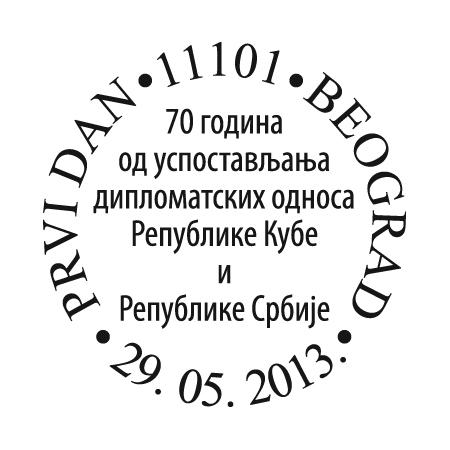
The year 2013. represents a significant jubilee for the Republic of Cuba and the Republic of Serbia, because it marks the 70th anniversary of establishment of diplomatic relations between those two countries.
By a royal decree of 31st August 1943, the government of the Kingdom of Yugoslavia in exile in London, has decided to close its consulate in Havana and instead to open a mission. From this point, the only one historically documented, relations between Serbia and Cuba were developing through the history of both countries, until nowadays, when the Serbian and the Cuban nations further deepen their friendly relations.
A brief review of this seventy years period since the establishment of diplomatic relations between Serbia and Cuba testifies about the solid grounds on which are based the relations between two countries, strengthened through a common history of struggle and sacrifice, based on a deep sense of friendship, solidarity and mutual sympathy between the two nations, with the will to continue the friendship, despite the challenges posed by the world in which we live.
Strong ties between the two countries exemplify the relations based on friendship and mutual respect. The support of the Yugoslav people at the beginning of the Cuban Revolution has helped the island during this difficult period to face political and military agression, and brutal blockade imposed at the time by the United States of America. Cuba for its part, has supported the right to territorial integrity of Serbia, referring to the Charter of the United Nations and respect of international law.
Nowadays, Serbia and Cuba are working on a more intensive and comprehensive utilization of the enormous potential that exists in both countries, at a time when relations between Belgrade and Havana are very good and when they receive a new zest, which is reflected in the reviving of the political dialogue at the highest level, in a yet modest economic and trade exchange, in mutual visits of delegations and organizing official meetings which are crowned with a meeting between the two countries’ Presidents, Tomislav Nikolić and Raul Castro, on 26thJanuary 2013, in the city of Santiago de Chile, during the EU and CELAC (Community of Latin American and Caribbean States) Summit.
Artistic realization of the stamp: Jakša Vlahović, academic graphic artist.
Flora – Orchids
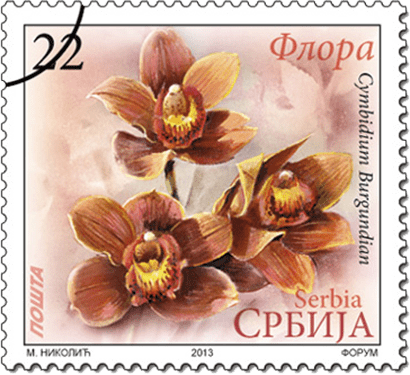







Cymbidium Burgundian
Fam. Orchidaceae
The perfect harmony of sumptuous dark Burgundy color and captivating flower scent of this orchid make it one of the most favorite among luxury cut flowers, and it is particularly appreciated in the United States and Great Britain. It was created by multiple crossing of other hybrids which resulted not only in exceptional color and texture of the flowers but also in their various odors. Thus, these orchids smell like a mixture of cinnamon and sandalwood, or have a smell like apple flowers, jasmine, lily of the valley and various types of citrus, or they have the rich scent of vanilla (which is also an orchid) and sandalwood. When decorating an interior, this orchid is given a central place, and its vase is being carefully chosen. One branch usually carries 9 - 11 flowers, 5 - 10 cm in diameter, and their durability is 3 - 5 weeks, sometimes longer.
Yellow Masdevalia Masdevallia Kimballiana
Fam. Orchidaceae
This hybrid with yellow or dark yellow-orange flowers of unusual shape is a result of direct crossbreeding of wild South American species: Masdevallia caudata with tricolor flowers (purple-white-golden-yellow), which grows in Colombia and Venezuela, and Masdevallia veitschiana with bright red flowers, which only lives in the northwest Peru. The genus Masdevallia got its scientific name after Jose Masdeval, a physician and botanist in the court of the Spanish King Charles III. About 500 species of this genus live from Mexico to Brazil, mostly on altitudes from 2.500 to 4.000m, and most of them on the Andes. They mostly grow on trees, but not as parasites but as epiphytes, then on the ground or wet rocks.
Lions moustache orchid Angraecum leonis
Fam. Orchidaceae
The most beautiful specimens of this orchid with graceful glittering white flowers grow in the nature on small groups of volcanic islands, known as the Comoros Islands, located between the African coast and Madagascar. It lives as epiphyte on trees that are used only as a substrate. Its dark green fleshy leaves are arranged in the shape of a fan, and there are up to 7 white fragrant flowers on the stalk. About 220 other species of the Angraecum genus live in the nature only in tropical and subtropical regions of Africa and on Madagascar, on altitudes from 200 to 1.200m. However, they also grow well in controlled greenhouse conditions and reward the efforts of breeders with elegant, long-lasting white flowers. There is an interesting fact that the scientific name of the genus Angraecum originates from Malay words “angrek“ or “angurek“, which means orchid.
Cymbidium Fort George
Fam. Orchidaceae
This is one of the most beautiful orchids of the Cymbidium genus with green flowers, created by crossing of two also very famous green-flowered orchids, the Cymbidium Baltic and the Cymbidium York Meredith, which are themselves hybrids raised through multiple crossing. The species, especially the many hybrids of the Cymbidium genus (some of which appeared more than 100 years ago) are considered to be the most wanted among luxury cut flowers, as well for the lavish beauty of their flowers with various colors and shades, as for their durability. The characteristic appearance of the flowers consists of the so-called lip (floral slip which differs from the others in shape, size and color) which has an archwise or scaphoid cavity, which was the reason why the Swedish botanist, Olaf Peter Swartz gave in 1799. the scientific name to this genus – Cymbidium, after the Greek word “kumbos“ which means dent. The genus includes more than 50 species which grow in India, China, Japan, Malaysia, Philippines and Borneo, as well as in northern Australia. Species with largest flowers, of which by crossbreeding were created various hybrids of extraordinary beauty, live at higher altutudes.
Artistic realization of the stamps: Miroslav Nikolić
Expert collaboration: Olja Vasić, Natural History Museum Belgrade, Serbia.
50th Ljubičevo Equestrian games








The story of the “Ljubičevo” horse farm, as one of the oldest horse farms in Serbia, started with Princess Ljubica’s search for a residence far from the city, best suited for her son Milan, who was anaemic and frequently ill. Thus, in 1858, along the right bank of Great Morava, one of the greatest monuments to the rule of Prince Miloš in Serbia arose, particularly significant for the region of Požarevac – the “Ljubičevo” horse farm. Stories tell of horses reared in this area since the age of the Nemanjić dynasty. Prior to the founding of the horse farm, this was the site of “Morava”, a grand agricultural estate of Prince Miloš Obrenović, one he donated to the state in 1860. Additionally, he ordered for the stables from Ćuprija, founded by Prince Alexander Karageorgevich, to be moved there. He did all this in favour of his people, and it all paid off subsequently. The farm saw many ups and downs, particularly during the two World Wars. For a while, it was a military stable. Today, it is one of the best known horse farms, winning numerous prizes at the greatest and most competitive races. As a tourist attraction, it is present in the offers of numerous tourist agencies across Serbia, mostly due to the first Ljubičevo Equestrian Games that brought about its restoration. A year after the first Games, the stable won the biggest race with the horse Vidra. Victories have kept coming ever since, justified by the horse farm to this day.
During his reign, Prince Mihailo renamed the grand agricultural estate “Morava” to “Ljubičevo”, in memory of his mother, Ljubica. This “oasis of peace and quiet”, as the visitors call the horse farm, survived difficult times, but was always revived. One of the best known horses is Ljubičevac, who won the Triple Crown in 1974, a feat that was not repeated for the next 20 years. Ljubičevac has a monument today, located within the facilities, one he posed for during his life. There are also many other extraordinary horses that made “Ljubičevo” famous and made it what it is today – the best known horse farm. “Ljubičevo” is the farm with the greatest number of prizes won at the best known races and one of the most visited tourist attractions in Serbia.
The following equestrian competition disciplines are shown on the stamps, such as: gallop race (on the first stamp), arrow shooting (on the second stamp), sword cutting (on the third one) and spear shooting (on the fourth stamp).
PE “Ljubičevo“ in cooperation with the Tourist Organization of Požarevac
Artistic realization of the stamps: Miroslav Nikolić
Joy of Europe






Every year since 1969, the children's meetings named by Joy of Europe gather together Eoropean children aged between 7 and 15, promoting frindship through various activities as a symbol of united children's world, but also representing a constant exchange of different culture backgrounds. Every October (from 1st to 6th Oct.) the authentic children's creativity demonstrated in close contact with citizens of Belgrade, open up to better interpersonal understanding and better understanding of children's world on the whole.
For 40 years now Children's Cultural Centre Belgrade organises the children art competition Joy of Europe, and the works of the most talented children from Europe and the world find their place on the special issue stamps and envelopes of the first day of the Post of Serbia.
In order to draw the attention of our children to the postal stamp as one of the state symbols, and to make them closer to the manner of its realisation and educational nature that is, among other things, characteristic for the noble hobby of philately, the Post of Serbia and Politika's Zabavnik have organised an artistic competition only for school childrenof the Republic of Serbia (from the 1st to 8th grade of the primary school).Thus it happend that also the most Beautiful works of children from this competition were put on the stamp, vignette and the special-issue envelope of the first day of this year issue Joy of Europe.The drawing of Rita Kavai( 9 years,2nd grade of Primary School J.J.Zmaj, Subotica) has won the 1st prize on this Competition and was reproduced on the stamp of 22,00 RSD nominal value. On the vignette of stamp pane of 22,00 RSD the second prize drawing of Noel Sarić (7 years, 1st grade of Primary School Sečenji Ištvan, Subotica- Kelebija). The drawing of Mihailo Nikolić (12 years, 5th grade Primary School Čegar, Niš) who won the third prize, is placed on the special-issue Envelope of the first day.
At this competition, the drawing of Maja Trifunović (6 years, Art worhshop Dlan, Obrenovac) Has won the third prize and it has become a motif on the stamp of 46,00 RSD nominal value. The vignette motif of this pane is the drawing of Ivan Vladimirov ( 5 years old, Arts School ARTEYA, Targovište, Bulgaria).
On the special issue envelope of the first day there are also the fallowing drawings: the prize for collection – Nadine Louisa ( 4 years, ANANDA Visual Arts School, Bandung, Indonesia) and third prize for collection 5-6 years – Elena Edelinski ( 6 year, Studio MANO, Children Art Studio MSUV, Novi Sad).На пригодном коверту првог дана налазе се и цртежи: похвала за колекцију – Надин Луиза (4 г, “Школа визуелних уметности АНАНДА, Бандунг, Индонезија) и 3 награда за колекцију 5-6 година – Елена Еделински (6 година, “Студио МАНО”, Дечји ликовни студио МСУВ, Нови Сад)
The professional cooperation on this issue realisation was provided by the Children's Cultural Centre Belgrade.
Graphic realization of the stamp: MA Marina Kalezić academic painter.
50th anniversary of the Constitutional Court




The Constitutional Court of Serbia has been the guardian of the Constitution and rule of law in the Republic of Serbia for the last 50 years. It is ranked among the oldest European constitutional courts for its existence for half a century. The mission of the Court started by introduction of constitutionality and legality control over the general acts in the Republic of Serbia ever since 1963, and it was extended in 2006 also to the human and minority rights and freedoms, guaranteed by the Constitution of the Republic of Serbia, the European Convention for Protection of human rights and fundamental freedom and the standards acknowledged by the International Law.
Therefore, this important jubilee, which is also marked by the issue of a jubilee postal stamp, at the same time presents a confirmation of perseverance and effectiveness of the Constitutional Court in the efficient protection of fundamental constitutional values, especially human and minority rights and freedoms. This is also a sort of testimony of the modern European constitutional and legal tradition acceptance, as an in-depth orientation of the present and future activities of the Constitutional Court in performing its competences entrusted to it by the Costitution.
Artistic realization of the stamp: MA Boban Savić, academic painter.
Stamp Day 170th anniversary of the first postal law in Serbia




The preparations for introduction of the public postal traffic in Serbia started in 1835, upon adoption of the Sretenje Constitution, by which the Ministry of Internal Affairs (then so-called, Popečiteljstvo vnutrenih dela in Slavoserbian, the then literary language in Serbia) was appointed to impose order, organise and manage post offices.
While the introduction of the public postal service was prepared, menzulan-tatar service has turned into the public postal network although without any legal regulations. Thus, on 25th May 1840 according to the old calendar, in the letter the then Ministry of Internal Affairs informed the Russian, Austrian and French Consulates that the post was established in Belgrade. The first post-office was located next to today’s taverna Question Mark and it was on this day that it received the stamp for cancelling letters which is known among philatelists today as “framed Belgrade”. As soon as June 4, a post office in Kragujevac was opened.
As Serbia was developing also the postal traffic in it was developing. During 1843, the postal traffic network already encompassed Valjevo, Loznica, Požarevac, Šabac, Brusnica, Jagodina, Smederevo, Čačak i Batočina. Although there are no preserved written documents on opening of most of the post offices, the letters with impressions of these towns which are kept in philatelistic collections today present an uncontested proof of postal development in Serbia. In the beginning of Serbian post offices operations only official and private letters and parcels, money and Serbian newspapers of that time (Novine serbske) were prepared and dispatched.
Development of postal system in Serbia brought about the necessity of adopting regulations so that further development of postal traffic could be regulated more precisely. The first legal act on establishment of the entire postal organisation was passed on 15th October 1843, according to the old calendar, under the name Organisation of the Postal Institution (Ustroenie Poshtanskog Zavedenia). By this Act it was ordered that the postal network connects all the places and towns in the territory of Serbia. The Ustroenie also determined the lines of regular postal traffic, both the main and the subordinate (soyuzne) postal lines.
The four main postal lines were: Belgrade-Radujevac, Belgrade-Aleksinac, Belgrade-Mokra Gora and Belgrade-Loznica. These lines included two post offices (in Belgrade and Aleksinac), thirty-four dispatch stations (”expeditions”) and thirty-six relay stations (”menzulanas”).
The act on regulation of postal service in Serbia was adopted by the end of 1843 named Nastavlenije for all vocations of postal activities and operations.
Artistic realization of the stamp: MA Nadežda Skočajić, academic painter – graphic artist.
Expert collaboration: Bora Stanković.
Christmas






The entire Christian world celebrates the Nativity of Chirst holidays on 25th December. However, three Orthodox Patriarchates - Jerusalem, Russian and Serbian, count the time according to the Julian calendar, and their believers, due to the difference of 13 days, celebrate Christmas on 7th January.
Christmas is considered as one of the most important and joyful Christian holidays, and its message is message of peace and love. Christmas in Serbia is commemorated three days. This is, above all, a family holiday, marked with numerous ancient traditions. On the eve of Christmas, so-called Badnji Dan (Day before Christmas), Badnjak (an oak-tree yule log) is brought into the house, a vigil lamp is lighted, and straw scattered across the floor, together with some sweets, prunes, walnuts, sugar cubes and coins hidden. The straw is there to symbolise the Nativity scene, the yule log is a symbol of longevity and steadiness of Christianity, and the warmth of love that Christ brings to us by His birth and arrival to the Earth. On the Christmas day, early in the morning, the church bells toll and announce the arrival and birth of Christ. The people go to church to the Christmas Liturgy and greet one another: “Christ is Born!”, answering: “He is truly Born!”
The stamps and envelope show icons from temples of the Serbian Orthodox Eparchy of Banat, found in Vršac and Bašaid. The Serbian Orthodox Church of the Transfer of the Remains of the Holy Father Nikolaj in the village of Bašaid, municipality of Kikinda, was erected in the style of classicism, between 1831 and 1833, during the time of the Metropolitan of Karlovci Stefan Stratimirović. Its interior is decorated by the works of the renowned Serbian painter Pavle Simić, created between 1862 and The Cathedral Church of Saint Nikolaj in Vršac was raised from the foundations between 1783 and 1785, on the location of an earlier temple from 1728. The iconostasis and pulpit, and later the choir and liturgical fans were cut by Aksentije Marković between 1787 and 1797, and in 1803. The iconostasis, choir, thrones and pulpit were painted by Pavel Đurković between 1804 and 1808, and the adaptation of Đurković’s icons on the iconostasis was undertaken in 1865.
The motif on the nominal 22.00 RSD stamp: The Birth of Christ, an icon from the iconostasis of the Church in Bašaid, the work of Pavle Simić (1866-67); the motif on the nominal 46.00 RSD stamp: The Birth of Christ, an icon from the iconostasis of the Cathedral Church in Vršac, an adaptation of the icon by Pavel Đurković (1807); the motif on the envelope: Throne Icon of the Holy Mother of God with Christ from the Church in Bašaid, (1863).
Graphic realization of the stamps: MA Nadežda Skočajić, academic painter – graphic artist.
Professional Cooperation: Serbian Orthodox Church, Eparchy of Banat.
200 years since the birth of Petar II Petrović Njegoš



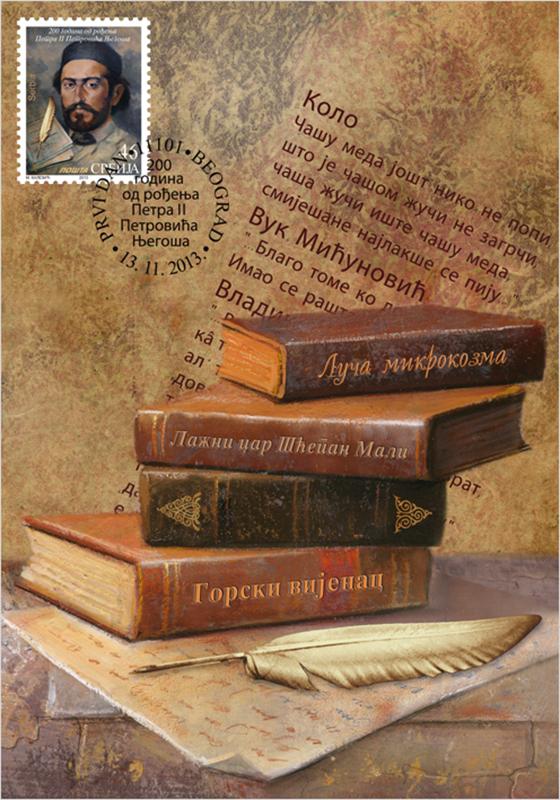
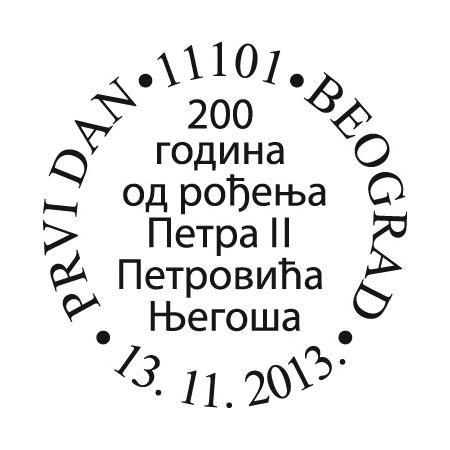
Petar II Petrović Njegoš (13. November 1813, Njeguši - 31. October 1851, Cetinje) was one of the greatest Serbian poets, the Prince-Bishop and ruler of Montenegro. He was born as the second son of Ivana Proroković and Toma Markov Petrović, the youngest brother of the bishop Petar I. He was also popularly known as bishop Rade, by his baptismal name Radivoje. He was educated in the Monastery of Cetinje, and in the Monastery of Topla, near Herceg Novi, he studied Italian language, mathematics, ecclesiastical singing, psalter and other subjects. Bishop Petar I declared him as his successor on 20. January 1827. After the death of his uncle, in 1831, Njegoš became monk and began to administer the state of Montenegro. In 1833, in Petrograd, he became bishop.
Njegoš was at the same time religious and secular leader of the Serbian people in Montenegro, where ruled a strong national consciousness and patriarchal morality, but also anarchy, tribal rivalry and vendetta. After coming to power, he began to impose order and modernize the society and state. He built schools and roads, founded courts of justice, and introduced taxation. It was really hard in such backward areas. He wrote „I am the ruler among barbarians, and I am barbarian among rulers“. In the spring of 1850. the bishop got ill of lung disease which he tried in vain to cure in Italy, and of which he died on 10. October 1851, in Cetinje. The Prince Danilo fulfilled in 1855. the legacy of Njegoš and conveyed his remains to Lovćen. The Lovćen chapel where he is buried was damaged by the storms and lightnings, but in 1879. Prince Nikola fortified the chapel and secured it with lightning rods. In 1916, when Austria conquered Montenegro, during First World War, his remains were conveyed to the Monastery of Cetinje.
On 23. September 1925, King Alexander Karađorđević conveyed his remains from Cetinje to the restored chapel, and in the seventies of the last century, at the spot of the old chapel at Lovćen was erected a mausoleum, created by the sculptor Ivan Meštrović.
Already as a boy, Njegoš began his poetic work, by imitating folk poetry, which he later on collected and published in the corpus „Serbian Mirror“. Vuk Karadžić considered that many of these poems dedicated to the recent Montenegrin battles were created by Njegoš himself.Later poetry was created under the strong influence of ancient classicism, which reflected indirectly and more formally. Among poems of Njegoš, in which prevails deep and thoughtful lyricism, we can distinguish the following: Montenegrin to almighty God, Faithful son of the night singing laudation to the thoughts and Ode to the Sun, and his most important works are: Microcosm Ray, Mountain Wreath and False Emperor Šćepan the Little.
Наука – Просвета













100th Anniversary of Founding of the Gymnasium in Novi Pazar
The Gymnasium in Novi Pazar was founded on 20th November 1913. by the Decreee of His Majesty King Peter I. Then, 48 students were enrolled in the first grade, two teachers were employed, as well as two part-time teachers, the school director and doctor. The Gymnasium in Novi Pazar calebrates its 100th anniversary with 1092 students, 60 teachers, and pedagogical- psychological, legal and accounting department. We have in our school the following departments: science and mathematics, social sciences, informatics and general. The classes are held in general purpose classrooms and chemistry, physics, biology, foreign languages, computer science and informatics classrooms.
During its development, the Gymnasium changed its name and location. Since 1972. until nowadays, it is located in Vuka Karadžića Street. The school has always shared the destiny of the environment and time in which it originated. It passed through periods of intensive growth but also stagnation. However, besides all the troubles, crisis and issues faced by the school, it was an institution with a very important cultural and educational mission and high reputation.
During its 100 years of existence, the Gymnasium was assigned the role of the bearer of cultural and educational development of Novi Pazar region and it was the symbol of the coexistence, true values and appreciation of singularity.
The Gymnasium was attended by prominent scientists, writers, artists, politicians, diplomats, officers, businessmen, doctors, engineers, teachers, lawyers, economists etc. Its students were Rasim Ljajić, Minister of the Republic of Serbia, Radan Džodić, Prof Dr. sc med, Ćemal Dolićanin, Professor Dr of Mathematical Sciences; Mehmed Slezović, academic painter and graphic artist; Prof Dr Budimir Šoškić, academician; Prof Dr Radovan Vučković, academician; Dr Ejup Mušović, historian and many others. During one century of its existence, more than 10.000 students have graduated.
Sabiha Mujezinović, prof and Nezrina Nicević, school psychologist
100th Anniversary of Founding of the Gymnasium in Prijepolje
The Gymnasium in Prijepolje was founded on 20th November 1913. by the Decreee of His Majesty King Peter I. It happened only a year after the liberation of the region from the Ottoman rule and the final annexation.
Its work was interrupted only twice, both times during the First and Second World Wars.
The Middle Polimlje experienced a real renaissance with its founding, as educated teachers arrived, who completed their studies in big European cities. The spirit of young high school students brought new life to the city and to the people. Particularly valuable is the fact that after the liberation, and centuries old, especially religious divisions, there was again trust, understanding and tolerance among the population, because young people of both religions sitting at school desks for the first time. Their impact on all social events becomes every day more and more pronounced.
The school was attended by many generations of students, hundreds of them have completed college education, and almost 80% of them working at responsible positions in the municipality have completed their education at the Gymnasium of Prijepolje. Over 90 of them acquired the academic title of MA and PhD.
The school was certainly helping a lot the educational development of the wider area of western Serbia. The Teacher’s College, the Evening School of Economics, and High Schools in Nova Varoš and Priboj were at that time founded in the scope of the Gymnasium of Prijepolje, which later grew into separate schools.
Today, the Gymnasium of Prijepolje is a modern educational institution, which has moved into a new building in 1997. This has created optimal conditions for successful work. Today, the school is attended by about 470 students in science and mathematics and social sciences departments. The school has 50 employees, of which 40 are in the teaching process. In addition to other numerous awards, the Gymnasium of Prijepolje has won in 2003. the Vuk Award.
Школу данас похађа око 470 ученика у друштвено језичком и природно математичком смеру. У школи је 50 запослених, од којих 40 у настави. Поред других бројних признања, Пријепољска гимназија је 2003. године добила Вукову награду.
Principal of the Gymnasium, Ljubomir Šuljagić
150th Anniversary of Founding of the Gymnasium in Pančevo
The Gymnasium in Pančevo was founded 150 years ago. First was formed the Imperial - Royal Lower Secondary School by the order of the War and Military Council of Vienna. The school became the Higher Secondary School, and since 1863/64 it was named the Imperial - Royal Higher Secondary School, and later the Classical Gymnasium. The Higher Secondary School in Pančevo was one of the most prestigious schools in Austria. Its students stood out in knowledge at the universities in Germany and Switzerland. When World War I began, the Gymnasium became a Military Hospital, and classes were held in the premises of other institutions. Between two world wars, the school developed into a state eight-grade gymnasium. Its reputation raised and the number of students increased. At the beginning of World War II, the Gymnasium was left again without premises. However, its spirit wasn’t broken, and the school continued to work in various city premises. After the war, the Gymnasium „Uroš Predić“ devotes itself to the professional specialization of teachers, the formation and development of sections, the creation of pedagogical and psychological services, the organization of excursions, cooperation with the parents... If we look back, among famous scientists, artists, athletes, doctors, teachers...we shall recognize the former „students“: Mihajlo Pupin, Uroš Predić, Vasa Živković, Miloš Crnjanski, Miroslav Antić, Jovan Bandur, Stojan Trumić, Dušan Vukajlović, Nebojša Glogovac, Nađa Higl... This rolling river of students and teachers is constantly shaping the unforgettable spiritual building of the Gymnasium. The look at this „building“ creates the awareness that gymnasiums represent the base for the development of spiritual life, creative and critical thinking, and knowledge which is constantly flowing over the imaginary boundaries, overcoming the attempt to be „framed“ and stopped on the wall of remembrance.
Expert collaboration: Gymnasium „Uroš Predić“, Pančevo.
175th Anniversary of Founding of the Gymnasium in Sremska Mitrovica
While drawing the portrait of the Gymnasium in Sremska Mitrovica, we go back 175 years, when on 2nd July 1838, by the order of the Court War Council, in Mitrovica started the first section of the fourth grade in the scope of the main three-grade school. In November that same year, the first disciples officially entered this section. It was the beginning of the biography of one of the oldest and most prestigious educational institutions in the region. The school has come a long way from the „small classical gymnasium“, Drawing school, to become, in half a century, the four-grade classical gymnasium, which was named the „State classical gymnasium of King Peter I the Great Liberator“ by the decree of King Alexander in 1929. Schortly after, the school moved to the newly built Educational rulers’ building after which it was named. This event was followed by the days of its greatest ascent and affirmation. The reorganization of the educational network, in post-war conditions, didn’t bypass the school, and in the sixties in the last century, it was named „Ivo Lola Ribar“. It will carry this name until the summer of 2007, when it will be finally named by the actual name. Today, the Gymnasium in Mitrovica is the oldest, and for its achievements and results the most important institution of secondary education in this part of Serbia. Through seventeen decades of existence, hundreds of important names of the overall science, culture and art, dozens of academics and most respected people in all areas of human activity acquired crucial knowledge. Mileva Marić Ajnštajn, wife of the creator of the theory of relativity also attended the Gymnasium in Sremska Mitrovica, as well as the actor Petar Kralj, playwright Siniša Kovačević. The historian Vasa Čubrilović and our most famous philologist and Hellenist Miloš N. Đurić were lecturers at this institution. The Gymnasium always provided the light of knowledge necessary for young people to move on in life. It was and it is still a source of new love, inspiration and endeavor. Future generations which will be educated in this creative and always new institution will mark the decades to come. The time spent in the Gymnasium will surely represent something valuable and most beautiful that happened to them during the period of growing up and intellectual maturation.
Đorđe Domazet
Expert collaboration: Gymnasium in Sremska Mitrovica.
Artistic realization of the stamps: Miroslav Nikolić
125 years since the birth of Кing Аlexander i Кarađorđević
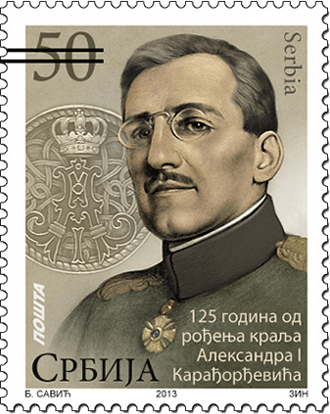




Alexander I Karađorđević (Cetinje, 16. December 1888 - Marseille, 9. October 1934), also known as Alexander the Unifier, the first King of the Kingdom of Serbs, Croats and Slovenes, and later of the Kingdom of Yugoslavia (1929 - 1934), was the second son of King Peter I and Princess Zorka, daughter of the King of Montenegro Nikola I Petrović and Queen Milena.
He spent his childhood in Montenegro, and completed primary school in Geneva. He was educated at the Military School in Saint Petersburg, and later (1903) in Belgrade, when his father Peter I became King of Serbia. In 1909, Alexander became heir to the throne, when his brother, Prince George renounced his claim to the throne. On 24. June 1914 Alexander became Regent of Serbia because King Peter I stepped down from the throne due to illness.
During the First Balkan War (1912), Alexander, heir to the throne as commander of the First Army fought victorious battles in Kumanovo and Bitola, and later in 1913. during the Second Balkan War, the Battle of Bregalnica. During World War I, he was the supreme commander of the Serbian army in the battles at Cer and Kolubara (1914), when the Serbian army defeated the army of the Austro-Hungarian monarchy. After the occupation (1915), Regent Alexander together with the Serbian army crossed Albania. He was the supreme commander when the Serbian army made the breakthrough of the Salonika front and won the battle at Kajmakčalan.
On 1. December 1918. was signed the Act on the creation of the Kingdom of Serbs, Croats and Slovenes. The Regent Alexander was crowned after the death of King Peter I (16. August 1921), and in 1922. he married Princess Maria of Romania, with whom he had three sons - Peter, Tomislav and Andrej.
In the new state, King Alexander conducted an agrarian reform that abolished the feudal system in agriculture, carried out the colonization of the border area in Banat, Bačka, Old Serbia and Macedonia, and reorganized the public administration by forming nine regional units and the city of Belgrade. He is credited for the creation of the alliance „Little Entente“ (Kingdom of Serbs, Croats and Slovenes, Romania and Czechoslovakia). Because of constant conflicts between Croatian and Serbian political parties, the King introduced dictatorship on 6. January 1929. and abolished the constitution. The same year, the Kingdom of Serbs, Croats and Slovenes got a new name „Kingdom of Yugoslavia“. The dictatorship lasted until 1931. when was declared the new constitution, the so called „forced constitution“.
During his visit to France, on 9. October, the King Alexander I was killed in Marseilles by the Croatian fascist and terrorist organization Ustaše and the Internal Macedonian Revolutionary Organization (VMRO). He was buried at Oplenac, in the Memorial Church of St. George, which has been built by his father King Peter I.
Artistic realization of the stamp: MA Boban Savić, academic painter.
160 years since the foundation of Kragujevac factory „Zastava Arms jsc”




After becoming the capital city, in 1818, as the geographic center of Serbia, Kragujevac was destinated for stronger development. The military industry was launched because, in Serbia, in the those days, the process of liberation and gaining independence was a priority.
On St. Petka, the 27th October 1853, the first cannons were successfully casted. The ceremony was attended by Prince Alexander Karađorđević.
The Foundry had the first steam engines (1853), the first military-artisan school was founded in 1854, the first quality control was introduced in 1856, the first industrial electric lighting in 1884. It was the nursery of engineering and technical thoughts, but also cultural development.
At the World Trade Fair in Paris (1889), the factory was awarded with six medals. The adaptation of the single-shot rifle Kokinka M1880 in the five-shot rifle M1880/1907 was done by the lieutenant colonel, Gojko Đurić. The rifle Mauser-Milovanović-Đurić was proclaimed the best in the world.
Between two World Wars, the Military Technical Institute is restored. The gun and ammunition factory was officially put into operation on 27th October 1928. and in Serbia was launched the first serial production.
After World War II, the turning point in the development of the factory was the establishment of an independent development in 1964. and the development of Kalashnikov family of automatic weapons M70.
The development of the factory Zastava Arms has always been connected with the cultural and historical development of the Serbian state. As a strategically important part of the defense system, the factory is still state owned.
The reputation of the factory is based, since its founding, on tradition, quality products and cosmopolitan spirit. 160 years ago, in Kragujevac were laid the foundations of the industrial development of Serbia, and today Zastava Arms is a recognized brand in the world.
Motifs on the stamp: Building (former) of the Cannon Foundry, built in 1882, today the Museum of the Old Foundry, Zastava Arms; drawing of the first tools made in the Cannon Foundry in Kragujevac M1853 (author of drawing Branko Bogdanović) and the machine for processing of cannon projectiles, Selesković system. Motif on the envelope: Administration Building, 1928 (the solemn opening on the occasion of the 75th anniversary of founding) and constructional documentation for the M1880/1907 rifle Mauser-Milovanović-Đurić
Graphic realization of the stamp: MA Nadežda Skočajić.
Expert collaboration: Zastava Arms Joint Stock Company, Marketing.
Joint stamp Issue Serbia – Algeria



Issuing of joint postal stamps of the two countries contributes to deepening and refining of their relations. Serbia and Algeria have found their tangential point in their cultural heritage in the field of ethnography.
Algerian carpets - The skill of carpet weaving in the territory of North Africa dates back to the Stone Age. It is believed that the Berbers, nomadic people from the North Africa, first started hand weaving with sheep wool and camel hair that were used for making robes, rugs, carpets and other items. Аll fabrics of more than two meters are known as carpets and serve as floorcloths, while the rugs are shorter and they have multiple purpose - hanging on the walls as decoration, used in prayer or serving as mats in nomadic tents. Even today, in Algeria, rugs and carpets are made using traditional method - hand weaving and knot making. The value of the carpet is determined by the beauty of the motifs and number of knots, which can reach up to 250.000 per square meter. The National Museum of Traditional Skills and Crafts in Algeria houses one of the largest and most valuable collections of Algerian carpets.
The Pirot carpets are unique in the world for their lack of a reverse side, as they have two identical fronts. They are made only of high-quality wool of indigenous breed of sheep grazing in the Balkan mountains. The best-quality wool, hand-span and very thinly woven, was selected for the weft of Pirot carpets that at the beginning were used as a horse cover placed beneath the saddle. For their ornate look and rich decorations used by the weaving women to embellish the carpets, they have moved to the house floors and walls and were used for various purposes. The Museum of Applied Art in Belgrade has more than 120 of hand-woven unique Pirot carpets in its collection. They were created in the period between the end of the eighteenth and the beginning of the twentieth century, considered as the golden age in creation of the Pirot carpets.
Artistic realization of the block: Nadežda Skočajić, academic painter - graphic artist and Radomir Bojanić, academic painter; Art design of the motif of Latin stamp: A. Kerbouche (Algerian).
Professional cooperation: Ethnographic Museum, Belgrade.
Стручна сарадња: Етнографски музеј, Београд.
900 years since the birth of Stefan Nemanja




The founder of Nemanjić dynasty and creator of a powerful Serbian medieval state, Stefan Nemanja is one of the most important Serbian medieval rulers. The youngest of four sons of the nobleman Zavida, born on 1113, overthrew his eldest brother Tihomir from the power between 1166 and 1168, and even rejected the supreme power of Byzantium.
The rule of Stefan Nemanja was marked with constant conflict with Byzantium and attacks on its territory in order to expand his power to the surrounding Serbian areas (Kosovo, Zeta, Travunija, Zahumlje and area around Neretva), but at the same time with loyal vassal relationship with Byzantium kings. Territorial conquests of the Grand Prince of Rascian lands, Stefan Nemanja, were finished in 1190 with a defeat in the battle on Morava, after which Rascia became vassal of Byzantium again, but Nemanja retained in his possession most of the territories he conquered.
He withdrew from the power and became a monk in 1196, and on the Council he appointed as a successor his middle son Stefan (known as the First-Crowned), who became a first Serbian king in 1217. Together with his youngest son Rastko (monk name Sava) he became one of the founders of Serbian orthodox church. He died on February 13th 1199 as a monk Simeon in the Hilandar monastery on the Mount Athos, which he rebuilt from the ground with his son Sava.
His relics were moved in 1208 to the monastery Holy Virgin the Benefactor – Studenica, which Stefan Nemanja built to be his mausoleum.
The reign of Stefan Nemanja represents a crucial period in the history and culture of Serbs. This era was marked by the building of monumental royal endowments in an authentic style of sacred architecture – Rascian style. Grand Prince Stefan Nemanja is considered to be the first great patron of Serbian orthodox temples. During his reign he founded and reconstructed several monasteries and churches on the territory of the Principality of Rascia, and in other countries. Except Studenica, Stefan Nemanja also built Monastery Saint Mother of Christ and Monastery Saint Nicholas near Kuršumlija, Monastery of Saint George in Ras (Temple of George’s Columns), Hilandar monastery.
He reconstructed Monastery of Saint Archangel Michael in Skoplje, Saint Nicholas church in Niš and Monastery of Saint Martyr Pantheleimon in Niš. He donated to the Christian holy shrines around the world – Church of Lord, Holy Grave and Church of Saint John the Forerunner in Jerusalem, Church of Saint Apostles Peter and Paul in Rome, Church of Saint Nicholas in Bari, Monastery of Saint Demetrios in Thessaloniki. Serbian Orthodox Church celebrates Stefan Nemanja as Saint Simeon the Myrrh-streaming.
Motif on the stamp: St. Simeon Nemanja founder of Studenica, frescoe from 1568. in the Studenica Church of the Mother of God Benefactress.
студеничкој цркви Богородице Добротворке.
Graphic realization of the stamp: MA Nadežda Skočajić, academic painter – graphic artist.
Professional Cooperation: Serbian Orthodox Church, Eparchy of Šumadija.